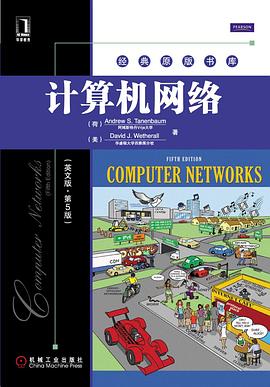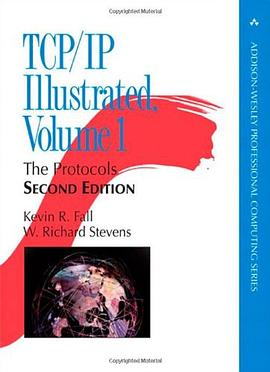

具體描述
本書是全球最具有權威性和經典性的計算機網絡教材,我國各大專院校也廣泛采用此書作為計算機網絡課程的基本教材。作者Tanenbaum 教授以高深的理論造詣和豐富的實踐經驗,在書中對計算機網絡的原理、結構、協議標準與應用等做瞭深入的分析與研究。
全書按照網絡協議模型(物理層、數據鏈路層、介質訪問控製子層、網絡層、傳輸層和應用層),自底嚮上逐層講述每一層所用的技術與協議標準,並給齣大量實例。全書內容全麵詳實,體係清晰閤理,敘述由簡入繁、層層深入,自底嚮上方法也符閤人類從底層到高層的認識規律,因此是公認的最適閤網絡入門的教材。
隨著計算機網絡的發展,本版對相關內容進行瞭大量修訂、更新和補充,具體更新內容如下:
•無綫網絡(802.12和802.16)。
•智能手機使用的3G網絡。
•RFID和傳感器網絡。
•使用CDNs進行內容分發。
•對等網絡。
•實時媒體。
•網絡電話。
•延遲容忍網絡。
著者簡介
Andrew S. Tanenbaum 國際知名的計算機科學傢,著名的技術作傢、教育傢和研究者,ACM和IEEE兩會高級會員,荷蘭皇傢藝術和科學院院士,荷蘭阿姆斯特丹Vrije大學計算機科學係教授。他講授計算機網絡、操作係統和計算機組成等課程30多年,教學成果卓著,其所著的多部計算機科學方麵的教材已成為該領域內的範本,得到學術界和教育界的廣泛認可,多次獲得ACM及其他學術組織頒發的各項榮譽,包括1994年ACM Karl V. Karlstrom傑齣教育奬、1997年ACM計算機科學教育傑齣貢獻奬、2002年Texty卓越教材奬、第10屆ACM操作係統原理研討會傑齣論文奬等,他還入選瞭《世界名人錄》。
David J. Wetherall 擁有美國麻省理工學院計算機科學博士學位,現為華盛頓大學西雅圖分校計算機科學與工程係副教授。他的研究領域是網絡係統,尤其是無綫網絡和移動計算、網絡測量和Internet協議的設計、隱私和安全。
圖書目錄
1 introduction 23
1.1 uses of computer networks, 25
1.1.1 business applications, 25
1.1.2 home applications, 28
1.1.3 mobile users, 32
1.1.4 social issues, 36
1.2 network hardware, 39
1.2.1 personal area networks, 40
1.2.2 local area networks, 41
1.2.3 metropolitan area networks, 45
1.2.4 wide area networks, 45
1.2.5 internetworks, 50
1.3 network software, 51
1.3.1 protocol hierarchies, 51
1.3.2 design issues for the layers, 55
1.3.3 connection-oriented versus connectionless service, 57
1.3.4 service primitives, 60
1.3.5 the relationship of services to protocols, 62
1.4 reference models, 63
.1.4.1 the osi reference model, 63
1.4.2 the tcp/ip reference model, 67
1.4.3 the model used in this book, 70
computer networks contents
fifth edition
preface 6
about the authors 10
1 introduction 23
1.1 uses of computer networks, 25
1.1.1 business applications, 25
1.1.2 home applications, 28
1.1.3 mobile users, 32
1.1.4 social issues, 36
1.2 network hardware, 39
1.2.1 personal area networks, 40
1.2.2 local area networks, 41
1.2.3 metropolitan area networks, 45
1.2.4 wide area networks, 45
1.2.5 internetworks, 50
1.3 network software, 51
1.3.1 protocol hierarchies, 51
1.3.2 design issues for the layers, 55
1.3.3 connection-oriented versus connectionless service, 57
1.3.4 service primitives, 60
1.3.5 the relationship of services to protocols, 62
1.4 reference models, 63
1.4.1 the osi reference model, 63
1.4.2 the tcp/ip reference model, 67
1.4.3 the model used in this book, 70
computer networks contents
fifth edition
preface 6
12?contents
1.4.4 a comparison of the osi and tcp/ip reference models, 71
1.4.5 a critique of the osi model and protocols, 73
1.4.6 a critique of the tcp/ip reference model, 75
1.5 example networks, 76
1.5.1 the internet, 76
1.5.2 third-generation mobile phone networks, 85
1.5.3 wireless lans: 802.11, 90
1.5.4 rfid and sensor networks, 93
1.6 network standardization, 95
1.6.1 who’s who in the telecommunications world, 97
1.6.2 who’s who in the international standards world, 98
1.6.3 who’s who in the internet standards world, 100
1.7 metric units, 102
1.8 outline of the rest of the book, 103
1.9 summary, 104
2 the physical layer 109
2.1 the theoretical basis for data communication, 110
2.1.1 fourier analysis, 110
2.1.2 bandwidth-limited signals, 110
2.1.3 the maximum data rate of a channel, 114
2.2 guided transmission media, 115
2.2.1 magnetic media, 115
2.2.2 twisted pairs, 116
2.2.3 coaxial cable, 117
2.2.4 power lines, 118
2.2.5 fiber optics, 119
2.3 wireless transmission, 125
2.3.1 the electromagnetic spectrum, 125
2.3.2 radio transmission, 129
2.3.3 microwave transmission, 130
2.3.4 infrared transmission, 134
2.3.5 light transmission, 134
contents?13
2.4 communication satellites, 136
2.4.1 geostationary satellites, 137
2.4.2 medium-earth orbit satellites, 141
2.4.3 low-earth orbit satellites, 141
2.4.4 satellites versus fiber, 143
2.5 digital modulation and multiplexing, 145
2.5.1 baseband transmission, 145
2.5.2 passband transmission, 150
2.5.3 frequency division multiplexing, 152
2.5.4 time division multiplexing, 155
2.5.5 code division multiplexing, 155
2.6 the public switched telephone network, 158
2.6.1 structure of the telephone system, 159
2.6.2 the politics of telephones, 162
2.6.3 the local loop: modems, adsl, and fiber, 164
2.6.4 trunks and multiplexing, 172
2.6.5 switching, 181
2.7 the mobile telephone system, 184
2.7.1 first-generation (1g) mobile phones: analog voice, 186
2.7.2 second-generation (2g) mobile phones: digital voice, 190
2.7.3 third-generation (3g) mobile phones: digital voice and data, 194
2.8 cable television, 199
2.8.1 community antenna television, 199
2.8.2 internet over cable, 200
2.8.3 spectrum allocation, 202
2.8.4 cable modems, 203
2.8.5 adsl versus cable, 205
2.9 summary, 206
3 the data link layer 213
3.1 data link layer design issues, 214
3.1.1 services provided to the network layer, 214
3.1.2 framing, 217
3.1.3 error control, 220
3.1.4 flow control, 221
2.4 communication satellites, 136
2.4.1 geostationary satellites, 137
2.4.2 medium-earth orbit satellites, 141
2.4.3 low-earth orbit satellites, 141
2.4.4 satellites versus fiber, 143
2.5 digital modulation and multiplexing, 145
2.5.1 baseband transmission, 145
2.5.2 passband transmission, 150
2.5.3 frequency division multiplexing, 152
2.5.4 time division multiplexing, 155
2.5.5 code division multiplexing, 155
2.6 the public switched telephone network, 158
2.6.1 structure of the telephone system, 159
2.6.2 the politics of telephones, 162
2.6.3 the local loop: modems, adsl, and fiber, 164
2.6.4 trunks and multiplexing, 172
2.6.5 switching, 181
2.7 the mobile telephone system, 184
2.7.1 first-generation (1g) mobile phones: analog voice, 186
2.7.2 second-generation (2g) mobile phones: digital voice, 190
2.7.3 third-generation (3g) mobile phones: digital voice and data, 194
2.8 cable television, 199
2.8.1 community antenna television, 199
2.8.2 internet over cable, 200
2.8.3 spectrum allocation, 202
2.8.4 cable modems, 203
2.8.5 adsl versus cable, 205
2.9 summary, 206
3 the data link layer 213
3.1 data link layer design issues, 214
3.1.1 services provided to the network layer, 214
3.1.2 framing, 217
3.1.3 error control, 220
3.1.4 flow control, 221
14?contents
3.2 error detection and correction, 222
3.2.1 error-correcting codes, 224
3.2.2 error-detecting codes, 229
3.3 elementary data link protocols, 235
3.3.1 a utopian simplex protocol, 240
3.3.2 a simplex stop-and-wait protocol for an error-free channel, 241
3.3.3 a simplex stop-and-wait protocol for a noisy channel, 242
3.4 sliding window protocols, 246
3.4.1 a one-bit sliding window protocol, 249
3.4.2 a protocol using go-back-n, 252
3.4.3 a protocol using selective repeat, 259
3.5 example data link protocols, 264
3.5.1 packet over sonet, 265
3.5.2 adsl (asymmetric digital subscriber loop), 268
3.6 summary, 271
4 the medium access control sublayer 275
4.1 the channel allocation problem, 276
4.1.1 static channel allocation, 276
4.1.2 assumptions for dynamic channel allocation, 278
4.2 multiple access protocols, 279
4.2.1 aloha, 280
4.2.2 carrier sense multiple access protocols, 284
4.2.3 collision-free protocols, 287
4.2.4 limited-contention protocols, 292
4.2.5 wireless lan protocols, 295
4.3 ethernet, 298
4.3.1 classic ethernet physical layer, 299
4.3.2 classic ethernet mac sublayer protocol, 300
4.3.3 ethernet performance, 304
4.3.4 switched ethernet, 306
and correction, 222
codes, 224
codes, 229
data link protocols, 235
simplex protocol, 240
stop-and-wait protocol for an error-free channel, 241
stop-and-wait protocol for a noisy channel, 242
protocols, 246
sliding window protocol, 249
using go-back-n, 252
using selective repeat, 259
link protocols, 264
sonet, 265
digital subscriber loop), 268
control sublayer 275
allocation problem, 276
allocation, 276
for dynamic channel allocation, 278
protocols, 279
280
multiple access protocols, 284
free protocols, 287
protocols, 292
lan protocols, 295
physical layer, 299
mac sublayer protocol, 300
performance, 304
ethernet, 306
3.2 error detection and correction, 222
3.2.1 error-correcting codes, 224
3.2.2 error-detecting codes, 229
3.3 elementary data link protocols, 235
3.3.1 a utopian simplex protocol, 240
3.3.2 a simplex stop-and-wait protocol for an error-free channel, 241
3.3.3 a simplex stop-and-wait protocol for a noisy channel, 242
3.4 sliding window protocols, 246
3.4.1 a one-bit sliding window protocol, 249
3.4.2 a protocol using go-back-n, 252
3.4.3 a protocol using selective repeat, 259
3.5 example data link protocols, 264
3.5.1 packet over sonet, 265
3.5.2 adsl (asymmetric digital subscriber loop), 268
3.6 summary, 271
4 the medium access control sublayer 275
4.1 the channel allocation problem, 276
4.1.1 static channel allocation, 276
4.1.2 assumptions for dynamic channel allocation, 278
4.2 multiple access protocols, 279
4.2.1 aloha, 280
4.2.2 carrier sense multiple access protocols, 284
4.2.3 collision-free protocols, 287
4.2.4 limited-contention protocols, 292
4.2.5 wireless lan protocols, 295
4.3 ethernet, 298
4.3.1 classic ethernet physical layer, 299
4.3.2 classic ethernet mac sublayer protocol, 300
4.3.3 ethernet performance, 304
4.3.4 switched ethernet, 306
contents?15
4.3.5 fast ethernet, 308
4.3.6 gigabit ethernet, 311
4.3.7 10-gigabit ethernet, 314
4.3.8 retrospective on ethernet, 316
4.4 wireless lans, 317
4.4.1 the 802.11 architecture and protocol stack, 317
4.4.2 the 802.11 physical layer, 319
4.4.3 the 802.11 mac sublayer protocol, 321
4.4.4 the 802.11 frame structure, 327
4.4.5 services, 329
4.5 broadband wireless, 330
4.5.1 comparison of 802.16 with 802.11 and 3g, 331
4.5.2 the 802.16 architecture and protocol stack, 332
4.5.3 the 802.16 physical layer, 334
4.5.4 the 802.16 mac sublayer protocol, 335
4.5.5 the 802.16 frame structure, 337
4.6 bluetooth, 338
4.6.1 bluetooth architecture, 338
4.6.2 bluetooth applications, 339
4.6.3 the bluetooth protocol stack, 340
4.6.4 the bluetooth radio layer, 342
4.6.5 the bluetooth link layers, 342
4.6.6 the bluetooth frame structure, 343
4.7 rfid, 345
4.7.1 epc gen 2 architecture, 345
4.7.2 epc gen 2 physical layer, 346
4.7.3 epc gen 2 tag identification layer, 347
4.7.4 tag identification message formats, 349
4.8 data link layer switching, 350
4.8.1 uses of bridges, 350
4.8.2 learning bridges, 352
4.8.3 spanning tree bridges, 355
4.8.4 repeaters, hubs, bridges, switches, routers, and gateways, 358
4.8.5 virtual lans, 360
4.9 summary, 367
16?contents
5 the network layer 373
5.1 network layer design issues, 373
5.1.1 store-and-forward packet switching, 374
5.1.2 services provided to the transport layer, 374
5.1.3 implementation of connectionless service, 376
5.1.4 implementation of connection-oriented service, 377
5.1.5 comparison of virtual-circuit and datagram networks, 379
5.2 routing algorithms, 380
5.2.1 the optimality principle, 382
5.2.2 shortest path algorithm, 384
5.2.3 flooding, 386
5.2.4 distance vector routing, 388
5.2.5 link state routing, 391
5.2.6 hierarchical routing, 396
5.2.7 broadcast routing, 398
5.2.8 multicast routing, 400
5.2.9 anycast routing, 403
5.2.10 routing for mobile hosts, 404
5.2.11 routing in ad hoc networks, 407
5.3 congestion control algorithms, 410
5.3.1 approaches to congestion control, 412
5.3.2 traffic-aware routing, 413
5.3.3 admission control, 415
5.3.4 traffic throttling, 416
5.3.5 load shedding, 419
5.4 quality of service, 422
5.4.1 application requirements, 423
5.4.2 traffic shaping, 425
5.4.3 packet scheduling, 429
5.4.4 admission control, 433
5.4.5 integrated services, 436
5.4.6 differentiated services, 439
5.5 internetworking, 442
5.5.1 how networks differ, 443
5.5.2 how networks can be connected, 444
5.5.3 tunneling, 447
contents?17
5.5.4 internetwork routing, 449
5.5.5 packet fragmentation, 450
5.6 the network layer in the internet, 454
5.6.1 the ip version 4 protocol, 457
5.6.2 ip addresses, 460
5.6.3 ip version 6, 473
5.6.4 internet control protocols, 483
5.6.5 label switching and mpls, 488
5.6.6 ospf—an interior gateway routing protocol, 492
5.6.7 bgp—the exterior gateway routing protocol, 497
5.6.8 internet multicasting, 502
5.6.9 mobile ip, 503
5.7 summary, 506
6 the transport layer 513
6.1 the transport service, 513
6.1.1 services provided to the upper layers, 514
6.1.2 transport service primitives, 516
6.1.3 berkeley sockets, 518
6.1.4 an example of socket programming: an internet file server, 521
6.2 elements of transport protocols, 525
6.2.1 addressing, 527
6.2.2 connection establishment, 530
6.2.3 connection release, 535
6.2.4 error control and flow control, 540
6.2.5 multiplexing, 545
6.2.6 crash recovery, 545
6.3 congestion control, 548
6.3.1 desirable bandwidth allocation, 549
6.3.2 regulating the sending rate, 553
6.3.3 wireless issues, 557
6.4 the internet transport protocols: udp, 559
6.4.1 introduction to udp, 559
6.4.2 remote procedure call, 561
6.4.3 real-time transport protocols, 564
5.5.4 internetwork routing, 449
5.5.5 packet fragmentation, 450
5.6 the network layer in the internet, 454
5.6.1 the ip version 4 protocol, 457
5.6.2 ip addresses, 460
5.6.3 ip version 6, 473
5.6.4 internet control protocols, 483
5.6.5 label switching and mpls, 488
5.6.6 ospf—an interior gateway routing protocol, 492
5.6.7 bgp—the exterior gateway routing protocol, 497
5.6.8 internet multicasting, 502
5.6.9 mobile ip, 503
5.7 summary, 506
6 the transport layer 513
6.1 the transport service, 513
6.1.1 services provided to the upper layers, 514
6.1.2 transport service primitives, 516
6.1.3 berkeley sockets, 518
6.1.4 an example of socket programming: an internet file server, 521
6.2 elements of transport protocols, 525
6.2.1 addressing, 527
6.2.2 connection establishment, 530
6.2.3 connection release, 535
6.2.4 error control and flow control, 540
6.2.5 multiplexing, 545
6.2.6 crash recovery, 545
6.3 congestion control, 548
6.3.1 desirable bandwidth allocation, 549
6.3.2 regulating the sending rate, 553
6.3.3 wireless issues, 557
6.4 the internet transport protocols: udp, 559
6.4.1 introduction to udp, 559
6.4.2 remote procedure call, 561
6.4.3 real-time transport protocols, 564
18?contents
6.5 the internet transport protocols: tcp, 570
6.5.1 introduction to tcp, 570
6.5.2 the tcp service model, 571
6.5.3 the tcp protocol, 574
6.5.4 the tcp segment header, 575
6.5.5 tcp connection establishment, 578
6.5.6 tcp connection release, 580
6.5.7 tcp connection management modeling, 580
6.5.8 tcp sliding window, 583
6.5.9 tcp timer management, 586
6.5.10 tcp congestion control, 589
6.5.11 the future of tcp, 599
6.6 performance issues, 600
6.6.1 performance problems in computer networks, 601
6.6.2 network performance measurement, 602
6.6.3 host design for fast networks, 604
6.6.4 fast segment processing, 608
6.6.5 header compression, 611
6.6.6 protocols for long fat networks, 613
6.7 delay-tolerant networking, 617
6.7.1 dtn architecture, 618
6.7.2 the bundle protocol, 621
6.8 summary, 623
7 the application layer 629
7.1 dns—the domain name system, 629
7.1.1 the dns name space, 630
7.1.2 domain resource records, 634
7.1.3 name servers, 637
7.2 electronic mail, 641
7.2.1 architecture and services, 642
7.2.2 the user agent, 644
7.2.3 message formats, 648
7.2.4 message transfer, 655
7.2.5 final delivery, 661
contents?19
7.3 the world wide web, 664
7.3.1 architectural overview, 665
7.3.2 static web pages, 680
7.3.3 dynamic web pages and web applications, 690
7.3.4 http—the hypertext transfer protocol, 701
7.3.5 the mobile web, 711
7.3.6 web search, 713
7.4 streaming audio and video, 715
7.4.1 digital audio, 717
7.4.2 digital video, 722
7.4.3 streaming stored media, 731
7.4.4 streaming live media, 739
7.4.5 real-time conferencing, 742
7.5 content delivery, 752
7.5.1 content and internet traffic, 754
7.5.2 server farms and web proxies, 756
7.5.3 content delivery networks, 761
7.5.4 peer-to-peer networks, 766
7.6 summary, 775
8 network security 781
8.1 cryptography, 784
8.1.1 introduction to cryptography, 785
8.1.2 substitution ciphers, 787
8.1.3 transposition ciphers, 789
8.1.4 one-time pads, 790
8.1.5 two fundamental cryptographic principles, 794
8.2 symmetric-key algorithms, 796
8.2.1 des—the data encryption standard, 798
8.2.2 aes—the advanced encryption standard, 801
8.2.3 cipher modes, 805
8.2.4 other ciphers, 810
8.2.5 cryptanalysis, 810
20?contents
8.3 public-key algorithms, 811
8.3.1 rsa, 812
8.3.2 other public-key algorithms, 814
8.4 digital signatures, 815
8.4.1 symmetric-key signatures, 816
8.4.2 public-key signatures, 817
8.4.3 message digests, 818
8.4.4 the birthday attack, 822
8.5 management of public keys, 824
8.5.1 certificates, 825
8.5.2 x.509, 827
8.5.3 public key infrastructures, 828
8.6 communication security, 831
8.6.1 ipsec, 832
8.6.2 firewalls, 836
8.6.3 virtual private networks, 839
8.6.4 wireless security, 840
8.7 authentication protocols, 845
8.7.1 authentication based on a shared secret key, 846
8.7.2 establishing a shared key: the diffie-hellman key exchange, 851
8.7.3 authentication using a key distribution center, 853
8.7.4 authentication using kerberos, 856
8.7.5 authentication using public-key cryptography, 858
8.8 email security, 859
8.8.1 pgp—pretty good privacy, 860
8.8.2 s/mime, 864
8.9 web security, 864
8.9.1 threats, 865
8.9.2 secure naming, 866
8.9.3 ssl—the secure sockets layer, 871
8.9.4 mobile code security, 875
8.10 social issues, 878
8.10.1 privacy, 878
8.10.2 freedom of speech, 881
8.10.3 copyright, 885
8.11 summary, 887
contents?21
9 reading list and bibliography 895
9.1 suggestions for further reading, 895
9.1.1 introduction and general works, 896
9.1.2 the physical layer, 897
9.1.3 the data link layer, 898
9.1.4 the medium access control sublayer, 898
9.1.5 the network layer, 899
9.1.6 the transport layer, 900
9.1.7 the application layer, 900
9.1.8 network security, 901
9.2 alphabetical bibliography, 902
index 921
· · · · · · (收起)
讀後感
在看这本书前我是有计算机网络基础的,本来是抱着复习的态度来看这本书的。但是越看越觉得以前的了解太片面了,这本书真的是像讲故事一样的娓娓道来,每一个协议、算法的提出都是层层递进,先讲需求,再讲实现,不会让你一头雾水的感觉。因为英文阅读比中文慢的原因我之前读的...
評分第一章看完了,讲解的确实详细,不过感觉看的有点累。 后面的物理层首先讲的就是傅立叶级数,伤脑筋啦。物理层、数据链路层、介质访问控制子层、网络层、传输层和应用层,不知道后面是不是很难,要怎么才能看完啊。 这本书竟然比c primer plus(都是入门类书籍~~~)还要厚。 ...
評分大学时的教材里最喜欢的书,没有之一。很少有技术书能让人读的时候像读小说一样不觉得累,同时内容精彩没有啰嗦和废话。大三上这门课时读过一遍,毕业将近5年后又重读了一遍,毕业后积累的很多知识发现书中都有提及到,并且虽然原著作者的写作时间比较早,但书中的内容在互联网...
評分大学时的教材里最喜欢的书,没有之一。很少有技术书能让人读的时候像读小说一样不觉得累,同时内容精彩没有啰嗦和废话。大三上这门课时读过一遍,毕业将近5年后又重读了一遍,毕业后积累的很多知识发现书中都有提及到,并且虽然原著作者的写作时间比较早,但书中的内容在互联网...
用戶評價
大師的經典作品就是不一樣,語言幽默風趣,就像是讀故事一般。
评分跟作者辦公室離得近,
评分我現在即將大三~選修瞭這門課~隻是老師講的太淺薄!於是我在圖書館尋尋覓覓~找到瞭最新版的書~雖然是外文書籍~但是看起來並不費勁!看瞭前幾章~內容講的通俗易懂!我決定用大三上的整個時光好好研究它!同是齣自作者的另外一本書,計算機操作係統~講的也很好!主要講解的是mini的linux內核隻有3000多行~是學習操作係統的好東西!最後~感覺能在學校裏遇到這兩本書實乃我的榮幸!
评分新版加上瞭智能手機使用的3G網絡,關注
评分我認為是本挺槽糕的教科書。網絡技術本身比較抽象的,因此需要作者自身的理論紮實與寫作功底。在對待新手而言,還是日本人更幽默與友善,推薦那本《網絡是怎樣連接的》。
相關圖書
本站所有內容均為互聯網搜索引擎提供的公開搜索信息,本站不存儲任何數據與內容,任何內容與數據均與本站無關,如有需要請聯繫相關搜索引擎包括但不限於百度,google,bing,sogou 等
© 2025 book.quotespace.org All Rights Reserved. 小美書屋 版权所有




















